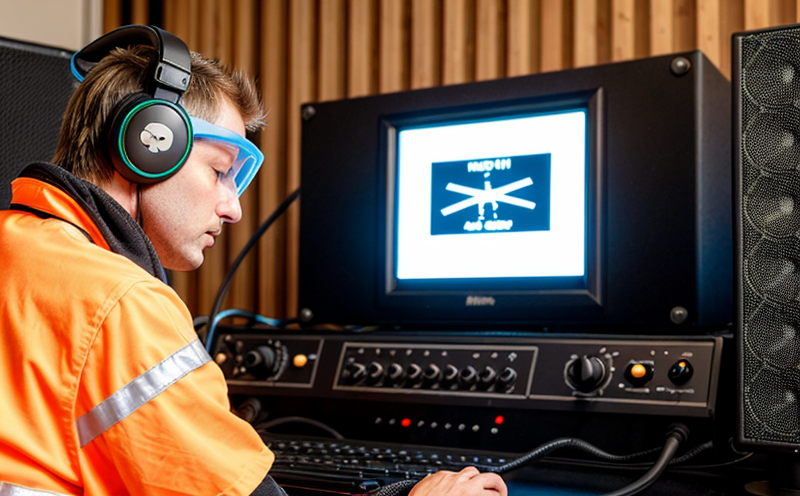ASTM F963 Maximum Permissible Sound Level Test
The ASTM F963-17 Standard Consumer Safety Specification for Toy Safety includes specific requirements regarding the safety of toys with respect to acoustic noise. This test evaluates whether a toy’s sound level exceeds the maximum permissible limits set forth in this standard, ensuring that children are not exposed to hazardous levels of noise which could cause hearing damage.
This testing is particularly critical for toys intended for infants and young children who may be more susceptible to auditory damage due to their proximity to the source. The test assesses the sound pressure level at various points around the toy, including where a child might hold or use it. Compliance with this standard is mandatory in many countries including the United States, Canada, and other regions that adopt ASTM standards.
The testing procedure involves placing the toy under controlled conditions to simulate real-world usage scenarios. The noise produced by the toy is measured using an appropriate sound level meter equipped with a broadband microphone and octave band filters. The test considers both steady-state and impulse sounds, ensuring comprehensive evaluation.
For toys that produce loud noises or have components that might be held close to the ear, the maximum permissible sound levels are particularly stringent. These include musical instruments, some educational toys, and any toy that might be used in a manner where it would be placed near the head of a child. The goal is to ensure that the volume does not exceed 85 dB(A) (A-weighted) for prolonged exposure or 100 dB(A) for brief periods.
During the testing process, several factors are considered to accurately reflect real-world use conditions. These include the angle at which a child might hold or play with the toy and the proximity of the toy’s sound source to their ears. The test setup must also account for environmental noise that may affect the measurement results.
The testing protocol is designed to be rigorous, ensuring that even minor deviations from the standard can be detected. This includes the use of calibrated equipment and trained personnel who are familiar with the nuances of toy design and potential safety issues. The process not only involves measuring sound levels but also assessing whether the toy’s design complies with all other relevant sections of ASTM F963.
Compliance with this test is essential for manufacturers seeking to ensure that their products meet regulatory requirements. It provides a robust framework for reducing risks associated with excessive noise exposure, thereby protecting children and enhancing consumer confidence in the safety of toys on the market.
Applied Standards
| Standard | Description |
|---|---|
| ASTM F963-17 Standard Consumer Safety Specification for Toy Safety | Includes requirements on noise levels to ensure toy safety. |
| American National Standards Institute (ANSI) S12.8 | Addresses the measurement of sound produced by toys and other small appliances. |
The ASTM F963-17 standard specifies that the maximum permissible sound level for toys intended to be held close to the ear or which produce loud noises should not exceed 85 dB(A) over a continuous period. For brief exposures, this limit can rise to 100 dB(A). Toys that are not in direct contact with the user’s ears but still produce significant noise levels must also meet these standards.
The standard further details how to measure sound levels accurately and provides guidance on which parts of a toy should be tested. This includes components like musical instruments, toys designed for loud noises such as talking books or animated figures, and any part that might come into close contact with the ear during play. Compliance with these standards is crucial for manufacturers aiming to meet regulatory requirements.
Eurolab Advantages
At Eurolab, we pride ourselves on providing comprehensive and accurate testing services that are tailored to the specific needs of our clients. Our expertise in ASTM F963 compliance ensures that toys meet all relevant safety standards, offering peace of mind for manufacturers and retailers.
We offer a range of benefits that set us apart from other laboratories:
- Comprehensive Testing Capabilities: We have state-of-the-art equipment to measure sound levels in accordance with ASTM F963 and other relevant standards.
- Experienced Personnel: Our team of experts is well-versed in toy safety regulations, ensuring that every test conducted meets the highest quality standards.
- Fast Turnaround Times: We understand the importance of timely results and strive to provide accurate reports within a short timeframe.
- Comprehensive Reporting: Our detailed reports are designed to help you make informed decisions about toy safety, compliance, and potential improvements.
By choosing Eurolab for your ASTM F963 maximum permissible sound level testing needs, you can be assured of reliable and accurate results that will help you maintain a safe product line.
Quality and Reliability Assurance
At Eurolab, we are committed to delivering high-quality services through rigorous quality management systems. Our testing processes for ASTM F963 compliance are designed to ensure that every toy passes stringent safety checks.
We maintain a robust Quality Management System (QMS) that is ISO/IEC 17025 accredited, ensuring our tests meet the highest standards of accuracy and reliability. This accreditation guarantees that our methodologies, equipment, personnel qualifications, and operational procedures comply with international best practices.
Our facilities are equipped with the latest technology for measuring sound levels in accordance with ASTM F963 requirements. We also have a dedicated team of experts who stay updated on regulatory changes and industry trends to ensure that our testing protocols remain current and effective.
In addition, we offer regular internal audits and external accreditation reviews to maintain our commitment to quality. This ensures that all tests conducted at Eurolab are accurate, reliable, and meet the highest international standards.





